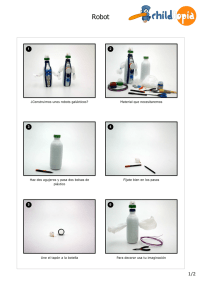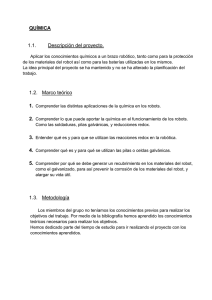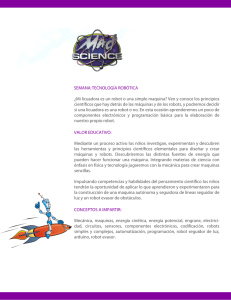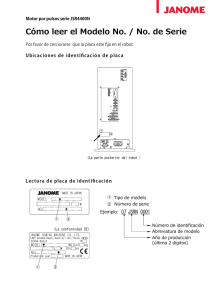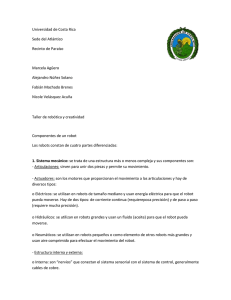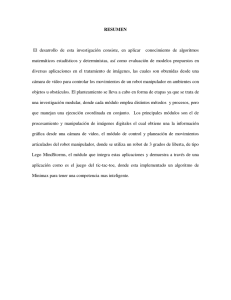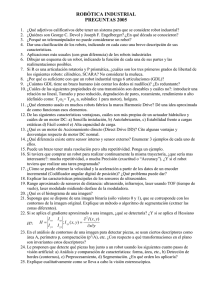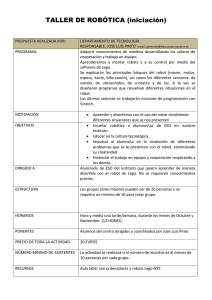Sistema Autónomo Robótico para Intersectar Objetivos Móviles de
Anuncio
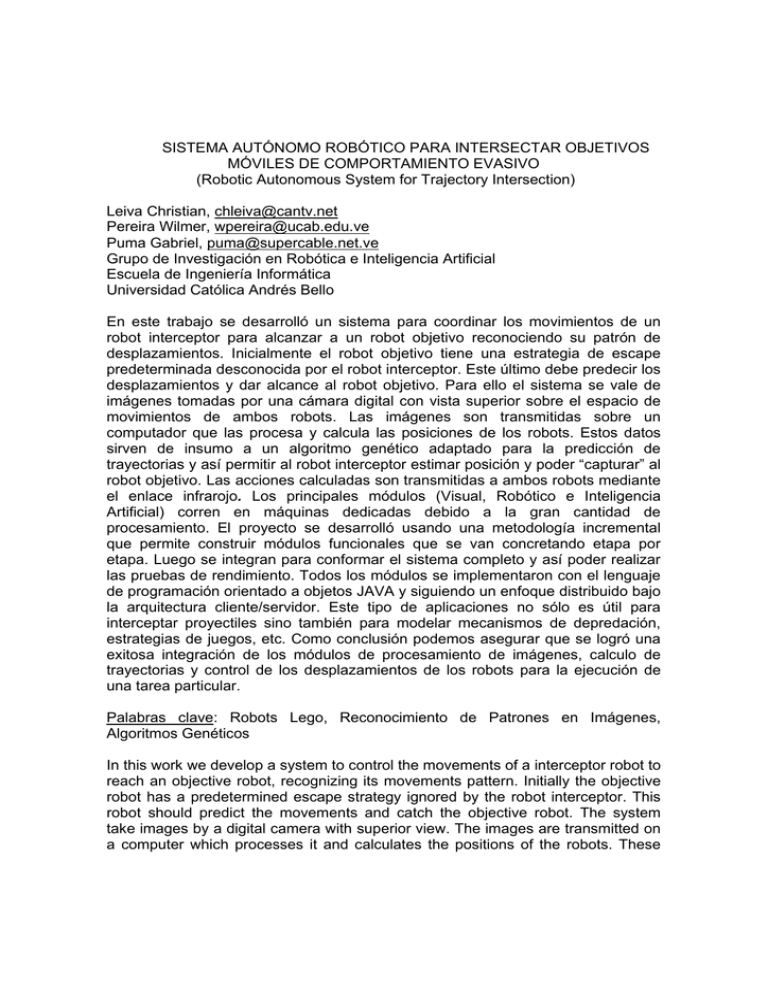
SISTEMA AUTÓNOMO ROBÓTICO PARA INTERSECTAR OBJETIVOS MÓVILES DE COMPORTAMIENTO EVASIVO (Robotic Autonomous System for Trajectory Intersection) Leiva Christian, [email protected] Pereira Wilmer, [email protected] Puma Gabriel, [email protected] Grupo de Investigación en Robótica e Inteligencia Artificial Escuela de Ingeniería Informática Universidad Católica Andrés Bello En este trabajo se desarrolló un sistema para coordinar los movimientos de un robot interceptor para alcanzar a un robot objetivo reconociendo su patrón de desplazamientos. Inicialmente el robot objetivo tiene una estrategia de escape predeterminada desconocida por el robot interceptor. Este último debe predecir los desplazamientos y dar alcance al robot objetivo. Para ello el sistema se vale de imágenes tomadas por una cámara digital con vista superior sobre el espacio de movimientos de ambos robots. Las imágenes son transmitidas sobre un computador que las procesa y calcula las posiciones de los robots. Estos datos sirven de insumo a un algoritmo genético adaptado para la predicción de trayectorias y así permitir al robot interceptor estimar posición y poder “capturar” al robot objetivo. Las acciones calculadas son transmitidas a ambos robots mediante el enlace infrarojo. Los principales módulos (Visual, Robótico e Inteligencia Artificial) corren en máquinas dedicadas debido a la gran cantidad de procesamiento. El proyecto se desarrolló usando una metodología incremental que permite construir módulos funcionales que se van concretando etapa por etapa. Luego se integran para conformar el sistema completo y así poder realizar las pruebas de rendimiento. Todos los módulos se implementaron con el lenguaje de programación orientado a objetos JAVA y siguiendo un enfoque distribuido bajo la arquitectura cliente/servidor. Este tipo de aplicaciones no sólo es útil para interceptar proyectiles sino también para modelar mecanismos de depredación, estrategias de juegos, etc. Como conclusión podemos asegurar que se logró una exitosa integración de los módulos de procesamiento de imágenes, calculo de trayectorias y control de los desplazamientos de los robots para la ejecución de una tarea particular. Palabras clave: Robots Lego, Reconocimiento de Patrones en Imágenes, Algoritmos Genéticos In this work we develop a system to control the movements of a interceptor robot to reach an objective robot, recognizing its movements pattern. Initially the objective robot has a predetermined escape strategy ignored by the robot interceptor. This robot should predict the movements and catch the objective robot. The system take images by a digital camera with superior view. The images are transmitted on a computer which processes it and calculates the positions of the robots. These data give the input to a genetic algorithm adapted for obtain the trajectory prediction. It allows to the robot interceptor to estimate position and trap the objective robot. The calculated actions are sent to both robots by a infrared connection. The main modules (Visual, Robotic and Artificial Intelligence) run in dedicated computer due to intensive CPU utilization. The project was developed using an incremental methodology that allows to build functional modules which are assembled phase by phase. All modules together are integrated in a system where we can carry out the tests. All modules were implemented with a object oriented language like JAVA and under client/server distributed architecture. This applications are used not only to intercept projectiles but also to model predator mechanisms, game strategies, etc. Like conclusion, we can assure that there is a successful integration of modules of images recognition, trajectory predictions and movements control of the robots for a particular task. Keywords: Lego Robots, Images Pattern Recognition, Genetic Algorithm
